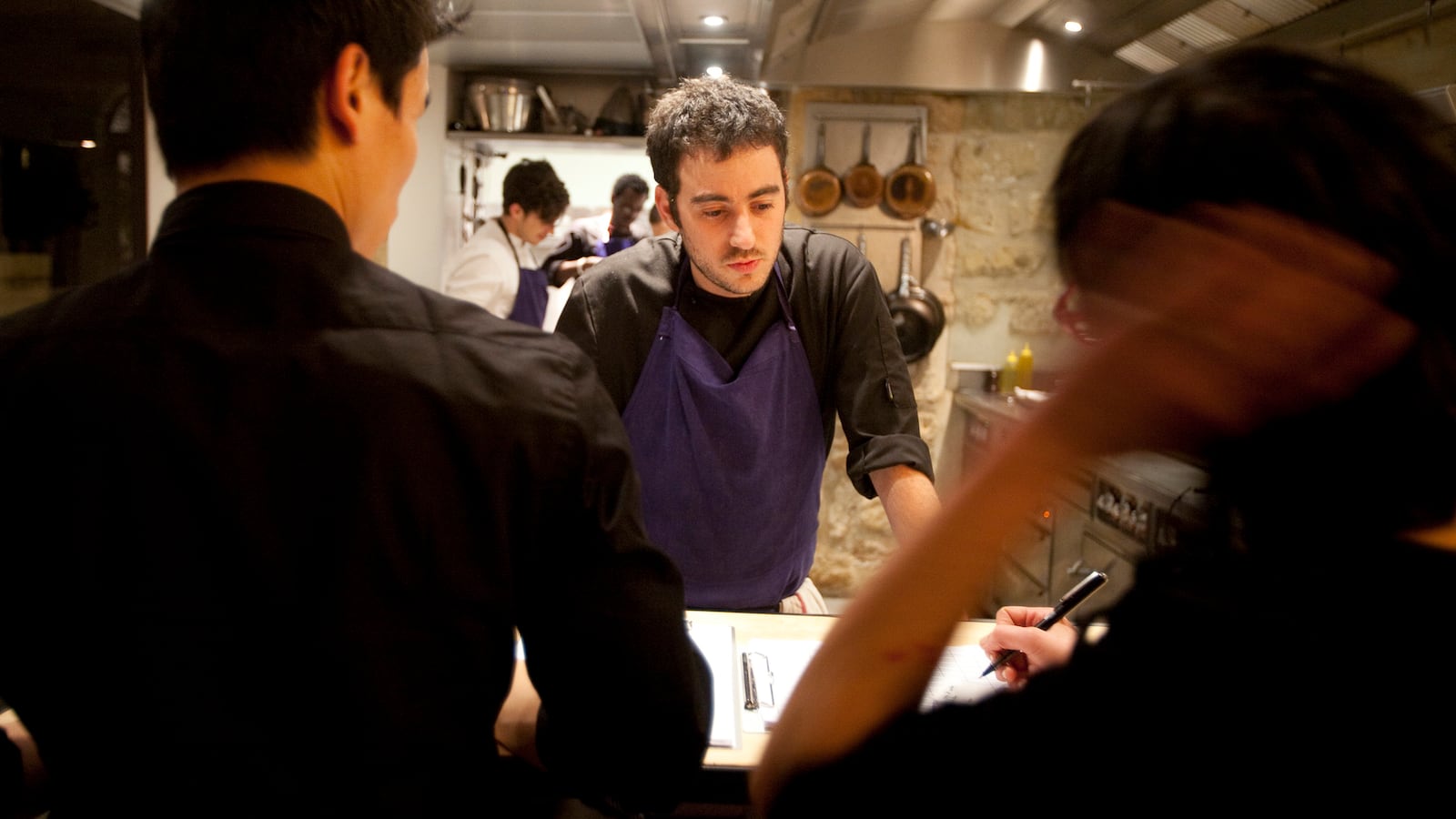Let me start with a confession. I am an unabashed Francophile. In fact, I long considered Paris my home and, geography notwithstanding, in many ways, I still do.
Having spent part of my childhood in Paris, my love for the city is infused with a double dose of nostalgia and cast entirely in rosy hues—well, actually, the golden hues of the city’s monuments when lit at night. I am a cliché, it’s true.
But my grand passion for France is thankfully tempered by a certain very affectionate humor about the French. And if there’s one thing I know about the French, it is that they like to keep things French. Particularly, when it comes to anything symbolic and most decidedly anything involving the word France. And why not? This is not jingoist nationalism, but simply a profound reverence for things like the terroir of Bordeaux or the cheese of the town of Roquefort or the lavender fields of Grasse or the mothership that is Notre Dame, and, of course, the great French chefs of yesteryear, today and tomorrow.
Imagine, then, my surprise when I read that Daniel Rose, an American, had been named the new Chef Partner of Air France. Now I should add here that Air France is not like United, Delta or JetBlue—it is, in every way, the national airline. The charming safety video onboard shows women in iconic French sailor stripes and scarves tied just so, as only a true Parisian can master. The flight attendants have impeccable manners, chic uniforms and can extol the virtues of every chateau on the wine list. Cheese, on-board, is not overly chilled and vacuum-sealed in suffocating plastic and the sparkling water is not carbonated. No doubt costs have been cut in certain departments, as they have in all airlines, but what has survived at Air France is unmistakably French.
And now, our very own chef from the midwestern town of Wilmette, Illinois, would be joining the ranks of Guy Martin, Anne-Sophie Pic, Andrée Rosier and Daniel Boulud to become a culinary symbol of France for Air France. It was such an uncharacteristic move, such a radical act that I knew I needed to meet Daniel Rose and see for myself just how the man was passing as French—or at least French enough.
The first thing you notice about Rose is that he has a boyish enthusiasm, amiable charm and disarming humility. But his humility is not for lack of confidence or ambition, both of which he has aplenty, but rather springs from an insatiable curiosity. It’s not every chef with a Michelin star, a spot on the World’s Best Restaurant List and a James Beard Award, who will jump at the chance to show you one of his favorite cookbooks, as Rose recently did when I saw him in Paris at his restaurant Chez La Vieille. He keeps a copy of Adrienne Biasin’s cookbook, Le table d’Adrienne, at the restaurant and will happily show you how closely he adheres to her recipes. It was actually Biasin’s restaurant before it was his, and he enjoys paying homage to his predecessor.
Chez La Vieille is the most casual of Rose’s restaurants. Located on a quiet corner in Les Halles, it is a neighborhood hang-out too good to be a neighborhood secret. La Bourse et La Vie, my favorite, whose name is a riff on the expression “your money or your life.” (Rose: “Why choose?”) But it is Le Coucou, in New York, that is his most celebrated, though it was Spring, a restaurant he opened in Paris in 2006 that made his reputation. For an American to open his first restaurant, and a French one no less, in Paris, would be an act of pure bravado for most. For Rose, it was anything but. He is not that chef who will tell you he started cooking at age five. In fact, his route to cooking—and to France—was far more haphazard.
“So, I ended up in Paris by accident,” Rose tells me over coffee one afternoon this fall at Le Coucou. “I didn’t know where I wanted to be, so I thought I would go to university in Paris. From St. John’s College in Santa Fe in New Mexico. I had studied philosophy and music and mathematics and ancient Greece and decided I wanted to go out in the world, but still needed to go to school, so I transferred to the American University in Paris, graduated as quickly as I could. Then,” he starts laughing, “I tried to join the French Foreign Legion. What was I thinking? I wasn’t thinking! I was thinking, but not clearly. At that age, you’re thinking what can I do that is meaningful? The Foreign Legion idea lasted one night. I still didn’t know I wanted to be a chef, but I had started loving restaurants. Restaurants are a sacred space in France. It’s very profound. And I wanted to stay in France, so I went to cooking school.”
After a short time at Institut Paul Bocuse in Lyons, Rose cooked in kitchens in Brittany, Avignon and Guatemala before joining Yannick Alléno at the Hotel Meurice in Paris. Alléno, at the time was trying for his third Michelin star. “I didn’t help him get three stars,” Rose is quick to tell me. “I was just a guy in the kitchen. If anything, I got in the way. Then I thought to myself, if I want to keep doing this, I need to open my own restaurant, so I found this little space in the 9th Arrondissement and opened Spring in 2006. It was a 140,000 euro investment. Half was the bank. Took me seven years to pay it off. But it was a thing. It was a fabulous thing.”
Two weeks after Spring opened, Le Figaro declared it the culinary event of the decade, and Daniel Rose became a household name among restaurant cognoscenti. “I think the French were charmed by the energy,” Rose elaborates. “I had opened in an area of Paris that was a bit dreary. It had the right energy.” And the right humility. Had he opened in a posh part of town, he might have ruffled a few feathers among his French colleagues. Instead, he was praised for having brought a neighborhood to life. Rose’s menu at Spring was French, but with a very contemporary focus on sourcing the best and freshest produce, dairy, seafood and meat he could find. As a newcomer, he was not burdened by long-standing relationships with purveyors, but could start with a blank slate and curate according to his taste.

A year later, he met the French chef Marie-Aude Mery, who would become his wife. They married in 2012 and now have two children, both born in Paris. But, at the time, the couple was cooking around the clock. In 2015, Rose opened La Bourse et la Vie, a restaurant of impeccable, classic French food. The au poivre sauce on his steak au poivre is profoundly rich with the depth that comes from patiently layering and reducing flavors over time, until the essence of each ingredient has been concentrated to its most exquisite note and then, of course, enriched with an abundance of fresh cream. (The dish is also on the menu at Le Coucou.) It is everything that a French sauce is meant to be—in other words, it’s clear Rose has adopted traditional technique and perfected it. He’s wise enough to leave what is great alone and not mess with it, and that surely appeals to the French. His baba au rhum is widely considered the best in Paris, as is his pot-au-feu, for which he simmers his stock for upwards of 12 hours, then uses fresh herbs, including chervil, to brighten and enliven the broth right before serving.
“Cooking in France has been codified and organized, and so you can study it,” Rose tells me. “You can live it, and you can study it.” That the French fell so hard for Rose is, no doubt, in part due to his absolute embrace of their time-honored techniques. He is that student who has surpassed his teacher with such grace as to illicit only pride.
Now, there’s something very French about Rose. Things I recognize in myself and those I know who’ve likewise lived in France—our sentence structure, for example, when we speak. It has a certain rhythm that’s hard to define but is recognizably different. A pleasure in the rituals and colloquial language surrounding food, from marketing to cooking to eating. That Rose is almost never seen not wearing a black t-shirt may be the exception. He wears black t-shirts, black jeans and sneakers with such regularity that one afternoon in Paris I overheard him asking his staff if anyone had a set of chef’s whites he could borrow. A television crew was coming to film him and wanted him “dressed as a chef.” No one did.
But there’s more to his uniform of black t-shirts. Rose would look equally at home as a barista in Brooklyn, an architect in Berlin, or playing in a Dublin rock band. Not wearing the classic French white toque and not presenting himself as a Grand Chef allows the French to see him as an unprepossessing youngish man of extreme talent rather than as an upstart or foreign infiltrator.
When Air France came courting, Rose immediately picked up on the challenge. “It was fun taking all the constraints of serving food at 30,000 feet and trying to deliver the most direct, simple Frenchness.” And that is exactly what he did. I never would have imagined that I’d request a recipe for airline food, but his gratin de volaille is so delicious that I did, and I now pass the recipe along to you.
INGREDIENTS:
- 4 Chicken thighs, bone in, skin off
- Salt & pepper, to taste
- 5 Yellow onions, minced
- 6 Tbsp Dijon mustard
- 1 cup Dry white wine
- 1/3 cup Extra-virgin olive oil
- Potato purée
DIRECTIONS:
This is a very simple recipe, but it does require advance planning, as the chicken needs to marinate overnight. Begin two to three days before serving. It feeds four.
Day 1: Liberally coat the chicken in mustard, cover and refrigerate for 12 hours to marinate.
Day 2: Preheat the oven to 200F. Sweat the onions in the olive oil over moderate heat until they begin to soften slightly, about 5 minutes. Add the white wine, bring to a simmer and cook until the wine has reduced by half. Remove from heat and season lightly with salt and pepper.
Lay half of the onion mixture in a baking dish.
Season the legs with salt and pepper and lay on top of the onions.
Cover the legs with the rest of the cooked onions.
Cover the dish with parchment paper and then again with aluminum foil. Bake for about an hour-and-a-half, turning the legs about midway through.
Remove the baking dish from the oven and let it come to room temperature. Refrigerate overnight. This step improves flavor, but, if you are pressed for time, it can easily be skipped.
Day 3: Preheat the oven to 350F.
Separate the meat from the bones and discard the bones.
Spread four cups of potato purée over the bottom of a small baking or gratin dish. Lay the chicken pieces evenly on top of the potatoes and then cover with the cooked onions and any remaining liquid. Bake until the onions color lightly and the food is hot. Serve immediately.

